The advertising world has witnessed a monumental shift, with the rise of streaming giants like Netflix, Hulu, Disney+, Amazon Prime Video, HBO Max, and Apple TV+ redefining media consumption.
The numbers speak for themselves: in July 2023, linear TV viewership dropped below 50 percent for the first time, while in the same month, CTV viewership hit a record 38.7 percent.
Although the 2024 US presidential election and major sporting events like the Olympics, Paralympics, and Euro 2024 will keep traditional TV viewers hooked this year, viewership is predicted to continue declining in the coming years.
Meanwhile, streaming services will continue gaining popularity — and ad-supported services provide a golden opportunity for advertisers.
In the UK, 68 percent of streaming subscribers prefer ad-supported tiers, while in the US, one in three viewers opt for ad-supported streaming — offering advertisers a huge potential viewer base.
As Shelby Saville, US chief investment officer at Publicis Media, so aptly puts it: “It is going to be the streaming war. Because money is coming in and competition is heating up, and that always equals a battle. And I think that battle is going to start [in 2024].”
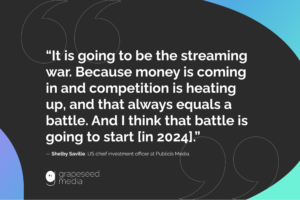
Want to know how to integrate streaming ads into your advertising strategy? Read on for a breakdown of streaming service advertising, its benefits, and six steps to get started.
What is Streaming Service Advertising?
Streaming service advertising refers to the practice of placing ads on internet-based streaming platforms.
Unlike traditional TV ads, which are broadcast to a wide audience, programmatic technology enables advertisers to tailor ads to the specific interests and behaviors of individual viewers (although programmatic capabilities are also starting to become available for linear and cable TV advertising).
Through AI-powered data analytics, personalization, and automation, advertisers can deliver highly relevant content to diverse audiences, increasing their return on ad spend (ROAS).
Understanding Streaming Services and Their Audiences
For advertisers, it’s essential to understand that each streaming service offers unique content and appeals to different demographics.
For instance, Netflix is renowned for its diverse original content, Hulu offers a blend of current TV shows and movies, while Disney+ caters to families and fans of Disney franchises.
Understanding these nuances is crucial for creating effective advertising campaigns that target the right audiences with the right messages for maximum impact.
Streaming service users are typically younger, tech-savvy audiences: 18-34-year-olds represent 63 percent of CTV viewership, followed by 35-54-year-olds, at 58 percent. Meanwhile, those aged 55+ make up the remaining 27 percent.
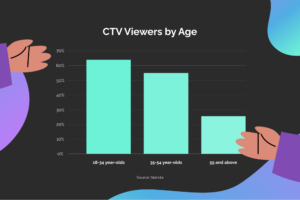
Millennial and Gen Z audiences are more likely to engage with ads that are relevant to their interests and viewing habits, which is where programmatic technology can help.
By analyzing vast amounts of data, it can predict which ads will resonate most with each viewer and provide them with highly personalized ad experiences that create a lasting impression.
What Are the Benefits of Advertising on Streaming Services?
CTV advertising is a personalized, targeted, and highly effective way to reach new, highly engaged audiences. Here are 10 of its biggest advantages for advertisers:
1. Precision targeting
Streaming platforms have access to a wealth of user data, including viewing habits, preferences, and demographics, which allows for highly targeted advertising, ensuring ads reach the most relevant audience.
For example, a sports apparel brand can target users who frequently watch live sports events.
2. Increased Engagement
Streaming service viewers are typically more engaged than traditional TV viewers — they’ve chosen to watch specific content and are often more receptive to ads.
Research shows that CTV ad viewers are engaged 71 percent of the time — 17 percent more traditional TV audiences — and 86 percent are willing to watch CTV ads, especially if those ads are relevant to their interests or the content they are viewing.
Given those numbers, it’s hardly surprising that CTV ads have a 30 percent higher ROI than other marketing channels.
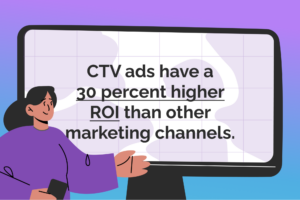
3. Reach Cord-Cutters and Cord-Nevers
Streaming services are particularly popular among younger demographics and those who have either never subscribed to traditional cable (cord-nevers) or have discontinued it (cord-cutters) — but not all advertisers are keeping up.
Even Netflix founder Reed Hastings admits he was slow to realize the importance of streaming advertising:
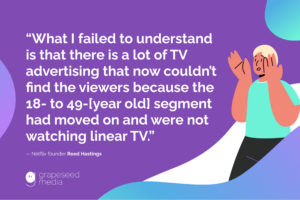
“What I failed to understand is that there is a lot of TV advertising that now couldn’t find the viewers because the 18- to 49-[year old] segment had moved on and were not watching linear TV,” he said at the New York Times Dealbook conference.
Still not convinced linear TV is going away? In 2022, the percentage of US households without any kind of telco, cable, or satellite TV service was 53 percent, up from 47 percent the year before — a figure that Statista projects will grow to 75 percent by 2025.
4. Advanced Analytics and Measurability
Streaming platforms offer advanced analytics, allowing advertisers to measure the effectiveness of their ads in real-time with metrics like view-through rates, engagement, and conversion rates. This level of detail is not typically available with traditional TV advertising.
5. Flexibility and Control
With streaming services, advertisers have greater control over their campaigns: it’s easy to start, stop, or adjust campaigns, test different ad versions, and use real-time data to optimize their strategies.
6. Creative Freedom
Streaming services often support a range of ad formats, from traditional video ads to interactive and immersive ads, providing opportunities for creative and innovative ad campaigns that can enhance viewer engagement.
Programmatic advertising also allows for dynamic creative optimization, offering advertisers the possibility to optimize creatives in real-time and maximize campaign performance.
7. Brand Safety
Streaming platforms often provide a more controlled environment compared to the open internet, offering better brand safety so advertisers can be confident about the context in which their ads appear.
8. Cost-Effectiveness
With programmatic buying, advertisers can often enjoy more cost-effective campaigns compared to traditional TV. The ability to bid on ad space and pay per impression (CPM) or per action (CPA) allows for better budget control.
9. Global Reach
With 3.08 billion OTT service users worldwide, many streaming platforms have a global audience, offering the potential for international reach that traditional TV might not provide.
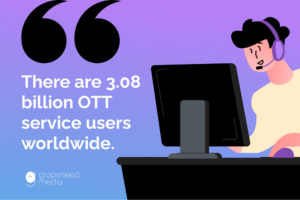
10. Reduced Ad Avoidance
Unlike traditional TV, where viewers might leave the room or change the channel during commercials, streaming service ads are often shorter and designed to be less intrusive, reducing the likelihood of ad avoidance.
How to Get Started with Streaming Service Advertising
Ready to launch your first streaming service ad campaign? Here are seven steps to get you started.
1. Define Your Goals, Target Audience, and KPIs
Success in streaming service advertising begins with clear objectives. Whether your goal is brand awareness, lead generation, or direct sales, it’s crucial to define your target audience and select appropriate KPIs, such as view-through rate, engagement, and conversion.
For example, a new online sustainable fashion retailer that wants to drive direct sales through an advertising campaign would start by identifying its target audience — environmentally-conscious consumers, primarily women aged 20-40, who have shown an interest in eco-friendly products.
For the KPIs, the brand might choose to track conversion rates (sales directly resulting from the ad), click-through rates (CTR) on the ad itself, and the cost per acquisition (CPA) to understand how effectively ad spend translates into actual sales.
2. Choose the Right Platform
The choice of platform should align with your campaign goals and target audience, and this decision is integral to the success of your campaign.
For example, a children’s educational app that aims to increase its subscriber base might choose Disney+ for its campaign, tailoring the content and tone of the ads to appeal to both parents and children.
3. Set a Budget and Bidding Strategy
Your budget should reflect your campaign objectives, and your bidding strategy, whether it’s CPM (cost-per-mille) or CPC (cost-per-click), should align with these goals. The cost of advertising varies across platforms and depends on ad format and targeting options.
For example, if a small online bookstore decides to advertise on Hulu with a limited budget, it could opt for a CPM strategy, ensuring the cost per thousand impressions stays within budget.
This strategy will help them manage their budget efficiently while still reaching a wide audience of book lovers.
4. Select Ad Formats and Craft Creatives
Streaming platforms offer various ad formats, but the key is to create content that resonates with the streaming audience. Narrative-driven ads, for instance, can boost viewer engagement.
For instance, a travel agency could launch a campaign on YouTube TV featuring interactive ads that allow viewers to explore different holiday destinations through 360-degree videos.
This narrative-driven, immersive approach will capture viewers’ attention and enhance engagement with the ad content.
5. Leverage Data for Targeting
Streaming services’ data analytics enable precise targeting. Personalizing ads to match individual viewer preferences and behaviors can dramatically improve the effectiveness of your campaign.
For example, a luxury car brand could use Amazon Prime Video’s data analytics to target potential customers based on their previous viewing habits, favoring content that suggests a high-income lifestyle.
It would create personalized ads to show car models that align with the viewers’ potential preferences, improving the relevance and effectiveness of the campaign.
6. Optimize Ads and Track Results
Testing different ad versions is crucial for refining targeting and content. Monitoring and analyzing campaign results provide insights for continuous improvement.
For instance, a health food brand could run several versions of its ad on Netflix, each featuring different product highlights and messaging.
By analyzing which version has the highest conversion rate and engagement, the brand can refine its future ad content to better resonate with health-conscious viewers, enhancing the overall campaign effectiveness.
7. Partner with a Programmatic Expert
Using programmatic advertising technology to its fullest potential requires deep technical knowledge combined with human guidance, and many brands have found they get the best results when they partner with programmatic experts like the Grapeseed Media team.
At Grapeseed Media, we are committed to combining cutting-edge AI capabilities with human creativity to help our clients navigate and succeed in this exciting new era of advertising.
Check out our case studies page to get a glimpse of some of the results we’ve achieved for our clients so far.
Make Advertising on Streaming Services Work for You
Streaming service advertising offers a powerful platform for reaching a diverse and engaged audience. As streaming service subscriptions grow, they will provide even more opportunities for finding new customers.
But that doesn’t mean advertisers should abandon linear TV altogether — it should still have a place in every advertising strategy.
Curious about how linear and CTV differ and how you can craft effective campaigns for each channel? Check out this guide to streaming vs. linear TV.






